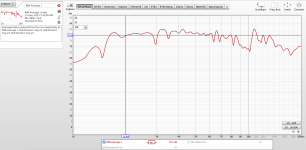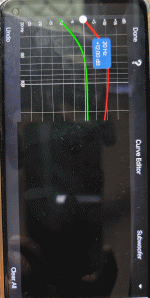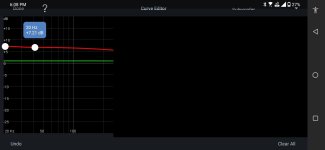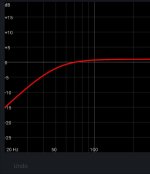Do you want a very honest answer? You simply have a room which is extremely problematic. If you belive in wonders, unicorns and Santa Clause, you may build absorber and bass trapps until you have no more space to enter the room, but it will still be terrible for listening to music. Usually people in your situation start experimenting until they get tired or funds are exhausted, then they accept what they have and live with it. With HT use this boom room may even sound mighty impressive if the right frequency is hit. Just pick movies without music 😉
Your vertical axis is too much compressed to reveal any interesting details. If you see my graphs each major division in v-axis is 5db. Can you repost your response with same settings.
Also use only var smoothing in rew.
Few thoughts.
1. 7.5db boost at 20hz seems to be too much when you are already power limited by ported design.
2. The downside of using large boost is it's gonna mess up sound in other areas of room.
3. Some of the nulls from room response, cannot be fixed by using boost. Solution - delay/physically moving sub or adding additional subs/ room treatment.
4. Can you remove all dsp eq, delay etc and measure at listening position and as wellas near field near sub. I would like compare and see what your room is doing. From there I can interpolate your sealed response.
5. To start with, you will have really good sounding lows if you target within +-5db response smoothness. Don't overdo the boost eq. I would not boost over 5db unless you have ample headroom.
6. Adding more subs is never overkill. It will de-stress your whole system and reduce distortion as you will be running at lower output per driver. You could even remove bridging and run two subs from single amp.
7. Also post your time domain response. It will reveal how bad or good your room is.
8. Again I always suggest sealed sub for badly or hardly treated room. Achieving "perfect" lows in a average sized room is a huge investment of time esp. if you are doing for the first time. You could take professional help but that will cost money.
9. Having said that find the best position/delay for your sub and work on smoothing response further before investing in additional gear.
Also use only var smoothing in rew.
Few thoughts.
1. 7.5db boost at 20hz seems to be too much when you are already power limited by ported design.
2. The downside of using large boost is it's gonna mess up sound in other areas of room.
3. Some of the nulls from room response, cannot be fixed by using boost. Solution - delay/physically moving sub or adding additional subs/ room treatment.
4. Can you remove all dsp eq, delay etc and measure at listening position and as wellas near field near sub. I would like compare and see what your room is doing. From there I can interpolate your sealed response.
5. To start with, you will have really good sounding lows if you target within +-5db response smoothness. Don't overdo the boost eq. I would not boost over 5db unless you have ample headroom.
6. Adding more subs is never overkill. It will de-stress your whole system and reduce distortion as you will be running at lower output per driver. You could even remove bridging and run two subs from single amp.
7. Also post your time domain response. It will reveal how bad or good your room is.
8. Again I always suggest sealed sub for badly or hardly treated room. Achieving "perfect" lows in a average sized room is a huge investment of time esp. if you are doing for the first time. You could take professional help but that will cost money.
9. Having said that find the best position/delay for your sub and work on smoothing response further before investing in additional gear.
Last edited:
Whatever you equalize inside this room, it will stay a square and resonate. You may build a wall to reduce one side by a meter, this would remove the double resonace of the square and distribute modes more even.
Your nulls and peaks in your room are created by either standing waves, boundary interface or reflections. Standing waves wholly dependent on your room size and shape. At first impression it might feel that you can't much other than may be bringing down a wall. But you could use the other two to tame the standing wave nulls to some degree by experimenting with listening position, adding subs etc. It's basically playing a balancing act between the room modes and other interferences. As I said it's time consuming but can be done but will never be "perfect".
Also don't worry about notch like dips you will barely notice in a mix. You priority should be those wide band dips in response.
You are correct, it wouldn't be fair for me me to expect a squarish room to go nice with bass with just one subwoofer, would it? 🙂 In DIY world building a sub and getting it sound like its supposed to be like one also requires a lot of co-ordination from room point of view and to make it further sound 'perfect' is where we should leave no stones unturned like bass traps and absorber but I am no where near to that and it won't make any sense without understanding the relativity between room and sub.Do you want a very honest answer? You simply have a room which is extremely problematic. If you belive in wonders, unicorns and Santa Clause, you may build absorber and bass trapps until you have no more space to enter the room, but it will still be terrible for listening to music. Usually people in your situation start experimenting until they get tired or funds are exhausted, then they accept what they have and live with it. With HT use this boom room may even sound mighty impressive if the right frequency is hit. Just pick movies without music 😉
As you said, it is what it is at the end of the day and I have already exhausted lot of time (and sleep) and energy on trying to get this work at optimal level. It looks as though a heavy piece of refrigerator which does not go friendly with movements and even if I try it's going to look awkward for the eyes if not for the ears 😀
It's a living Hall and unfortunately cannot even think. I wish I could take my system into a 16 (L) x 11 (W) foot room.Whatever you equalize inside this room, it will stay a square and resonate. You may build a wall to reduce one side by a meter, this would remove the double resonace of the square and distribute modes more even.
If I remove EQ and Delay, it would take all the sparkling magic away as I already tested it and didn't feel the low end (20hz to 30hz) without boost. Given its not dedicated HT sub, I felt the need for the boost.Your vertical axis is too much compressed to reveal any interesting details. If you see my graphs each major division in v-axis is 5db. Can you repost your response with same settings.
Also use only var smoothing in rew.
Few thoughts.
1. 7.5db boost at 20hz seems to be too much when you are already power limited by ported design.
2. The downside of using large boost is it's gonna mess up sound in other areas of room.
3. Some of the nulls from room response, cannot be fixed by using boost. Solution - delay/physically moving sub or adding additional subs/ room treatment.
4. Can you remove all dsp eq, delay etc and measure at listening position and as wellas near field near sub. I would like compare and see what your room is doing. From there I can interpolate your sealed response.
5. To start with, you will have really good sounding lows if you target within +-5db response smoothness. Don't overdo the boost eq. I would not boost over 5db unless you have ample headroom.
6. Adding more subs is never overkill. It will de-stress your whole system and reduce distortion as you will be running at lower output per driver. You could even remove bridging and run two subs from single amp.
7. Also post your time domain response. It will reveal how bad or good your room is.
8. Again I always suggest sealed sub for badly or hardly treated room. Achieving "perfect" lows in a average sized room is a huge investment of time esp. if you are doing for the first time. You could take professional help but that will cost money.
9. Having said that find the best position/delay for your sub and work on smoothing response further before investing in additional gear.
I never wanted to run Audyssey as it always gives us a early & smooth roll off below 40hz but took a shot at the end of the process with only little improvements. However mid bass takes all the advantage of speakers sensitivity and ported design and comes out strongly with few db increase.
Graph now showing frequencies in incremental of five. The bandwidth of the dips are actually not that wide as its fluctuates between 2 to 3hz differences.

I will probably test fresh without EQ / Delay and run Audyssey XT to see what sort of improvements it can do before playing around with EQ later.
The only part where I did not put much efforts is the placement and I am gonna try and move around to see if it can improve the response by any means.
As a last resort, I will look at adding another one adjacent to the room but that requires investment and lot of time to build one.
You just need to keep an eye on cone excursion which large boost and live with distortion of its audible.
You cannot add in your old sub to smooth out response a bit?
I don't think audyssey rolls off bass below 40hz.
It's might just be the distance settings messing up sound.
You cannot add in your old sub to smooth out response a bit?
I don't think audyssey rolls off bass below 40hz.
It's might just be the distance settings messing up sound.
I never saw the -20db lights blinking up and only use 45% of amp power and high pass filter set at safe levels. Tested with Edge of Tomorrow clips, no port noise on the opening scene bass notes and sounded good on all action scenes at the loudest level for my ear.
My existing sub is sealed coupled with passive radiator and I am really not sure how this mix will come out but since it is active model, I have the additional task of powering it on/off as this can only go as far as to the right side of the room.
I think Audyssey got it wrong measuring the distance as 29.4 feet when it should be around 11 feet unless the nature of the measurement for sub waves are fundamentally different that it AVR set it to 29 feet as opposed to measuring other speakers which came close to actual measurement.
My existing sub is sealed coupled with passive radiator and I am really not sure how this mix will come out but since it is active model, I have the additional task of powering it on/off as this can only go as far as to the right side of the room.
I think Audyssey got it wrong measuring the distance as 29.4 feet when it should be around 11 feet unless the nature of the measurement for sub waves are fundamentally different that it AVR set it to 29 feet as opposed to measuring other speakers which came close to actual measurement.
This is the default subwoofer curve (green) from Audyssey editor app. You can adjust the curve to your like and upload back into AVR. The max boost you can do is +12 db from 20hz and above. As you can see the curve roll off, no matter how hard you try you cannot change the smooth roll off. This is intentionally done as a universal way to work with every subwoofer.
Attachments
I use android. You see the default green curve is flat as opposed to rolled off on mine. What’s your version? 1.10.0?
I think the green curve is based on measurement of your actual speaker rolloff.
For eg. This is how my center channel looks like and matches my designed winisd simulations and umik measurements.
For eg. This is how my center channel looks like and matches my designed winisd simulations and umik measurements.
Attachments
Last edited:
- Home
- Loudspeakers
- Subwoofers
- Help with decision on SB Audience Bianca 18SW450 sub (home theater)


